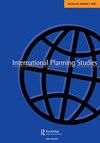The emergence of ‘performative planning’: a case study of waterfront regeneration in Kaohsiung, Taiwan
IF 1.5
Q4 REGIONAL & URBAN PLANNING
引用次数: 3
Abstract
ABSTRACT This paper examines the shifting planning logics and design principles presented in the emergence of ‘performative planning’ that frames the motivations and visions of recent megaprojects. I consider the emblematic landscape, persuasive imaginary and affective presence through which a regeneration megaproject manipulates public emotions as a tactic of performative planning. I suggest that performative planning is a constructed governing process through which prevalent affects are structured to justify subsequent policy decisions and actions. Based on a case study of ‘Asia New Bay Area’ project in Kaohsiung, Taiwan, this paper demonstrates that performative planning has increasingly underlined the shifting nature of spatial planning from rationality-based to emotion-orientated approaches. It also unfolds a major shift from crisis management to crisis adaptation, wherein public desires and emotions are now given significant consideration in both the policy agenda and the actual design of a regeneration megaproject.“行为规划”的出现:台湾高雄滨水重建个案研究
本文探讨了在“执行规划”的出现中呈现的不断变化的规划逻辑和设计原则,这些规划和设计构成了最近大型项目的动机和愿景。我认为象征性的景观,有说服力的想象和情感的存在,通过这些再生大型项目操纵公众情绪,作为一种表演规划的策略。我认为,执行性规划是一个构造好的治理过程,通过这个过程,普遍的影响被构造起来,以证明后续的政策决定和行动是合理的。本文以台湾高雄“亚洲新湾区”项目为例,论证了表演性规划越来越强调空间规划从理性导向向情感导向的转变。它还揭示了从危机管理到危机适应的重大转变,其中公众的愿望和情绪现在在政策议程和再生大型项目的实际设计中都得到了重要的考虑。
本文章由计算机程序翻译,如有差异,请以英文原文为准。
求助全文
约1分钟内获得全文
求助全文
来源期刊

International Planning Studies
REGIONAL & URBAN PLANNING-
CiteScore
4.60
自引率
4.80%
发文量
20
期刊介绍:
Planning, at urban, regional, national and international levels, faces new challenges, notably those related to the growth of globalisation as both an objective socio-economic process and a shift in policy-maker perceptions and modes of analysis. International Planning Studies (IPS) addresses these issues by publishing quality research in a variety of specific fields and from a range of theoretical and normative perspectives, which helps improve understanding of the actual and potential role of planning and planners in this context.
 求助内容:
求助内容: 应助结果提醒方式:
应助结果提醒方式:


